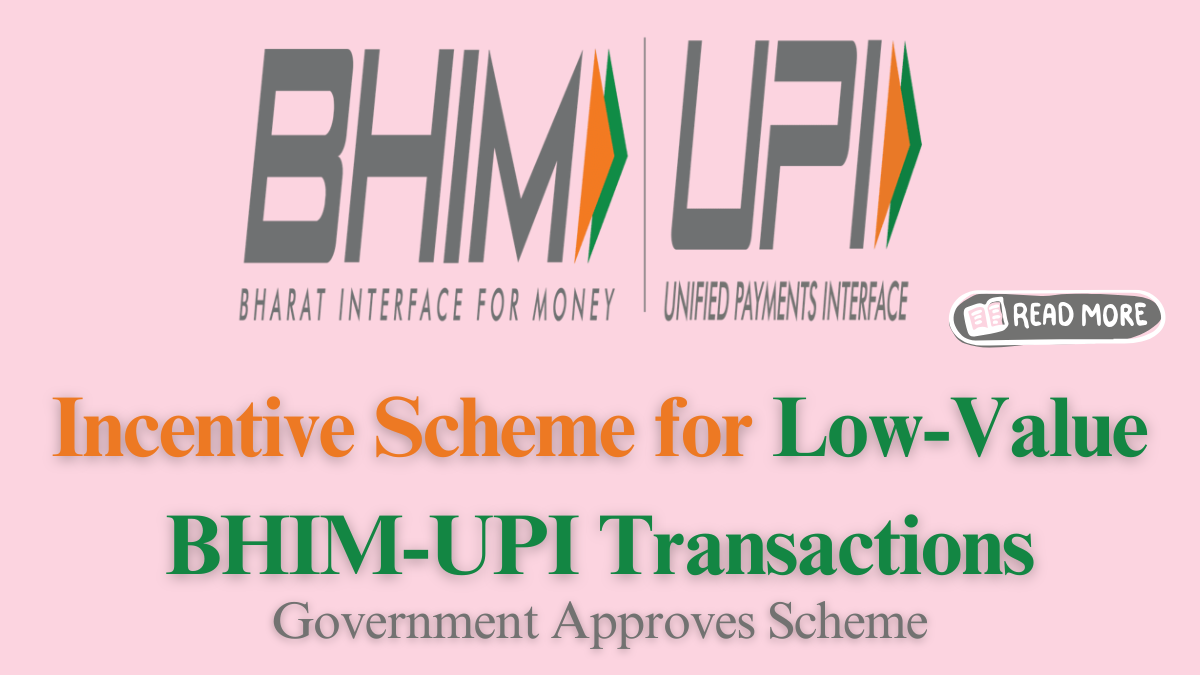The Union Cabinet, under the leadership of Prime Minister Narendra Modi, has recently approved a new Incentive Scheme aimed at boosting low-value BHIM-UPI transactions from Person to Merchant (P2M). This initiative is part of the government’s ongoing push to promote digital payments and enhance the adoption of UPI technology among small-scale merchants. The scheme is designed for the financial year 2024-25 and will be implemented with a total budget of Rs. 1,500 crore.

Key Features of the Incentive Scheme
The newly approved scheme aims to provide financial incentives to merchants who engage in low-value UPI transactions. The details of the scheme are as follows:
- Eligibility: Only small merchants conducting Person-to-Merchant (P2M) transactions of up to Rs. 2,000 are covered under this scheme.
- Incentive Rate: Merchants will receive an incentive of 0.15% of the value of each transaction within the specified amount.
- Disbursement of Funds:
- 80% of the approved claim will be released to acquiring banks immediately, without any preconditions.
- The remaining 20% will be contingent on fulfilling two key performance requirements:
- 10% will be granted if the technical decline rate of the acquiring bank is below 0.75%.
- The final 10% will be provided if the system uptime of the acquiring bank exceeds 99.5%.
Advantages of the Scheme
This initiative offers several advantages for both small businesses and the broader digital economy:
1. Promotes Cashless Transactions
The scheme encourages merchants to adopt cashless payment systems, helping move towards a digital economy. With seamless transactions, both customers and merchants will find it easier and more efficient to complete business dealings.
2. Affordable Digital Payment Solutions
Small merchants, who may otherwise hesitate to adopt digital payment systems due to high costs, will benefit from the scheme. The incentives provided will make it more financially viable for them to accept UPI payments without additional burdens.
3. Faster and Secure Cash Flow
The scheme will ensure that small merchants receive payments faster than traditional methods, thereby improving their cash flow. Additionally, the security features of UPI transactions will help mitigate the risks associated with cash handling.
4. Encouraging Financial Inclusion
One of the most important goals of this scheme is to improve financial inclusion by making digital payment options accessible to tier 3 to tier 6 cities, rural areas, and even remote parts of the country. Solutions like UPI Lite and UPI 123PAY are specifically designed to cater to areas with limited internet connectivity.
5. Performance Incentives for Acquiring Banks
The requirement for banks to maintain high levels of system uptime and a low technical decline rate ensures that the payment systems will be available round the clock, providing uninterrupted service to merchants and consumers.
Purpose of the Scheme
The main objective of this scheme is to boost the use of the BHIM-UPI platform and increase the volume of digital transactions. The government has set a target of Rs. 20,000 crore in total transaction volume for the financial year 2024-25. Other key goals include:
- Promoting UPI adoption among small merchants and customers.
- Expanding UPI usage in rural areas and smaller towns through initiatives like UPI Lite and UPI 123PAY.
- Ensuring that payment systems are reliable by keeping technical issues to a minimum and maintaining high system uptime.
Encouraging Digital Payment Growth
The Indian government has consistently supported the digital payment ecosystem, viewing it as a tool for financial inclusion and a key driver of economic development. The BHIM-UPI platform is a cornerstone of this vision, and by removing transaction charges for merchants, it helps push the nation closer to its goal of a cashless economy.
Since the introduction of UPI, several measures have been implemented to encourage usage, such as the abolition of Merchant Discount Rate (MDR) for UPI transactions and RuPay Debit Cards, which means merchants don’t have to pay any transaction fees to use these services.
Government’s Long-Term Vision
The Indian government aims to build an inclusive payment infrastructure that caters to all businesses, regardless of size or location. With the introduction of UPI 2.0 and UPI Lite, more solutions are being provided to feature phone users and those in areas with limited internet access. This comprehensive approach will make digital payments accessible even in the most underserved regions.
Conclusion
The Cabinet’s approval of the Incentive Scheme for low-value BHIM-UPI transactions is a significant step towards encouraging small merchants to embrace digital payments. The scheme is expected to play a crucial role in financial inclusion, promoting a cashless economy, and ensuring the widespread adoption of UPI technology. Small merchants will benefit from no additional cost to accept digital payments, and they will also be incentivized to adopt more efficient, secure payment methods.
Frequently Asked Questions (FAQs)
1. Who qualifies for this incentive scheme?
Small merchants conducting low-value UPI transactions of up to Rs. 2,000 are eligible.
2. What is the rate of the incentive offered under this scheme?
Merchants will receive 0.15% of each qualifying transaction as an incentive.
3. What is the disbursement process for the funds?
The acquiring banks will receive 80% of the incentive claim immediately, while the remaining 20% is contingent upon fulfilling performance criteria like low technical decline rates and high system uptime.
4. What are the performance criteria for receiving the remaining 20% of the incentive?
To receive the remaining 20%:
- The technical decline rate should be below 0.75%.
- The system uptime of the acquiring bank should be over 99.5%.
5. For how long will this scheme be applicable?
The scheme will be operational from April 1, 2024, to March 31, 2025.
Click here to learn more.
Pari is a passionate writer known for captivating stories that blend imagination and reality. Inspired by travel, history, and everyday moments, Pari crafts narratives that resonate deeply with readers.
